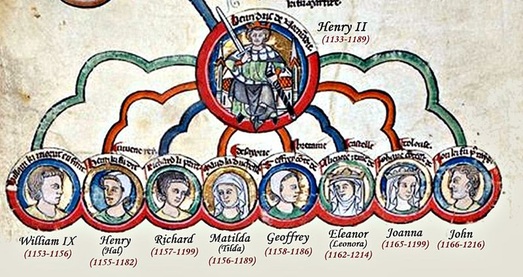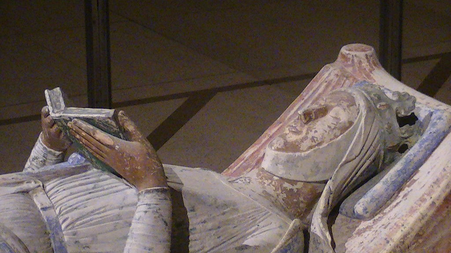 Henry II & his children, Royal 14 B VI, Membrane 6 © British Library, London.
Henry II & his children, Royal 14 B VI, Membrane 6 © British Library, London.
Eleanor of Aquitaine, 1124-1204
Ancestral Roots Line 110:26
Daughter to William X, Duke of Aquitaine, consort to Louis VII of France, secondly Henry II, king of England. Eleanor was one of the most powerful, influential figures with a far-reaching impact on western Europe during the High Middle Ages. In 1137, her father William joined a pilgrimage to Santiago de Compostela dying unexpectedly on the trip. On his deathbed, concerned about Eleanor’s safety, he expressed his wish to see king Louis VI of France as protector of his fifteen-year-old daughter and to find her a suitable husband realizing with her inheritance of his vast estate she would be the most sought-after bride of her generation. Louis VI naturally accepted this guardianship and within three months the heiress of Aquitaine was married to his own son, Louis VII.
Ancestral Roots Line 110:26
Daughter to William X, Duke of Aquitaine, consort to Louis VII of France, secondly Henry II, king of England. Eleanor was one of the most powerful, influential figures with a far-reaching impact on western Europe during the High Middle Ages. In 1137, her father William joined a pilgrimage to Santiago de Compostela dying unexpectedly on the trip. On his deathbed, concerned about Eleanor’s safety, he expressed his wish to see king Louis VI of France as protector of his fifteen-year-old daughter and to find her a suitable husband realizing with her inheritance of his vast estate she would be the most sought-after bride of her generation. Louis VI naturally accepted this guardianship and within three months the heiress of Aquitaine was married to his own son, Louis VII.
|
Christmas Day 1145, Louis VII announced his intention of going on a crusade; Eleanor soon decided to also participate with her royal ladies-in-waiting and as the feudal leader of some 300 non-noble Aquitainian vassals from her duchy. Even before the Crusade, Eleanor and Louis were becoming estranged, their differences were only exacerbated while they were abroad. After a brief attempt at reconciliation claiming he was ‘more monk than man’ Eleanor and Louis’ marriage was annulled in 1152 with assurances her lands would be restored to her.
|
Within eight weeks after the annulment Eleanor and Henry were married and two years later Henry became king of England. Throughout their marriage Eleanor continued to administer her own lands of Aquitaine. In 1173, she gave full support to her sons as they rebelled against Henry and although the revolt was quickly suppressed and Eleanor was imprisoned for sixteen years. In 1189, upon his father’s death one of Richard’s first acts as king was to release his mother from her prison. That same year Richard joined the Third Crusade and Eleanor acted as queen regent during his absence. In 1193, returning from the Crusades Richard was captured and held hostage by Henry VI, Holy Roman Emperor who demanded the astronomical ransom of 150,000 marks for his release. Eleanor raised the ransom and in 1194 Richard was released. In 1200, to solidify relations between England and France 80 year old Eleanor arranged a marriage between her granddaughter, Blanche of Castile and Dauphine of France. Eleanor died in 1204 and was entombed in Fontevraud Abbey next to her husband Henry and son Richard. Her tomb shows her reading a bible decorated with magnificent jewelry. By the time of her death she had outlived all of her children except for king John of England and queen Eleanor of Castile. Eleanor is credited with establishing and preserving many of the courtly rituals of chivalry.

Read her letters: https://epistolae.ctl.columbia.edu/woman/24.htm
References and Further Reading
References and Further Reading
- Crouch, Martha Carlin and David Crouch. Lost Letters of Medieval Life English Society 1200-1250. University of Pennsylvania Press, 2013.
- “Eleanor of Aquitaine.” Foundations for Medieval Genealogy. ENGLAND, KINGS 1066-1603. Chapter 3. KINGS OF ENGLAND 1154-1399, A. KINGS OF ENGLAND 1154-1399. HENRY d’Anjou. Web. 08 October 2016. //fmg.ac/Projects/MedLands/ENGLAND,%20Kings%201066-1603.htm#Stephendied1154B.
- Fines, John. Who’s Who in the Middle Ages. Barnes & Noble Books, 1995.
- Holmes, Urban T. Jr. Daily Living in the Twelfth Century, Based on Observations of Alexander Neckham in London and Paris. Wisconsin Press. 1952.
- Jackson-Laufer, Guida M. Women Who Ruled: A Biographical Encyclopedia. Barnes & Noble Books, 1998.
- Labarge, Margaret Wade. A Small Sound of the Trumpet, Women in Medieval Life. Beacon Press, 1986.
- Meade, Marion. Eleanor of Aquitaine: A Biography. Penguin Books, 1977.
- Medieval Women’s Latin Letters. https://epistolae.ctl.columbia.edu/women
- Mitchell, Linda E. Portraits of Medieval Women: Family, Marriage and Politics in England 1225-1350. Palgrave McMillan, 2003.
- Richardson, Douglas. Royal Ancestry: A Study in Colonial and Medieval Families. vol. 1 pp 24.4, pp 129.i; vol. 3 pp 21.6. 2013.
- Weir, Alison. Eleanor of Aquitaine: a Life. Ballentine Books, 2008.
